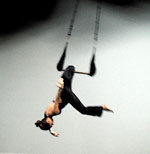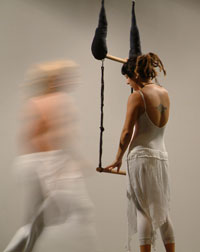


|
|
|
By Gene Armstrong THE ARIZONA DAILY STAR From the sublime to the obvious, O-T-O Dance addresses the changing landscape of Tucson's downtown area in its new full-length work ``Urban Gaits.'' The ambitious work, seen during its final dress rehearsal yesterday morning, weds artistic director Anne Bunker's modern-dance choreography with a collage-like electronic score by Chuck Koesters, video by Nancy Solomon, wood set pieces by Cynthia Miller and poetry and lyrics by Charles Alexander. It plays through Sunday in the Tucson Center for the Performing Arts. O-T-O has staged ``Urban Gaits'' on the center's floor, as if the work has grown too big to inhabit simply the stage. The performance area is like a naturalistic thrust, with audience members surrounding it on three sides. That makes some of the sight lines difficult - Lee Anne Hartley's beautiful bird-like solo, which opens the second act, is tough to see from some seats. But the members of O-T-O expect this. As Bunker said in her introduction yesterday, viewers are meant to see some things and miss some others, rather like life. Bunker displays good choreographic ideas here, and she even shows a little growth, especially in the coordination of tribal-style movement for the entire 10 dancers - eight group members and two apprentices. The characters' waking and morning rituals in early scenes and the later techno dancing scene (at a place called ``The Club'') seem a bit too literal, but are among the most recognizable. That served the concert well at yesterday's matinee for schoolchildren. Solomon's video imagery communicates the flavor of downtown Tucson realistically but also uses tight focus to make our urban landscape more dramatic. Throughout the work, O-T-O employs four fixed-point trapezes, which have become a trademark for the company. During a couple of early scenes, the devices seem superfluous. But in the section titled ``Common Gatherers,'' several elements, including the trapezes, combine in a beautiful mise en scène. While four dancers float in the trapezes and Solomon's cinematic Tucson icons dance on the walls, Koesters' electronic music seems to connote a sense of traveling. All the dancers contribute committed, energetic performances, even a passel of child guest stars. But the long, lithe lines of Stacey Haynes and centered presence of Charles M. Thompson are most impressive in this production. |
